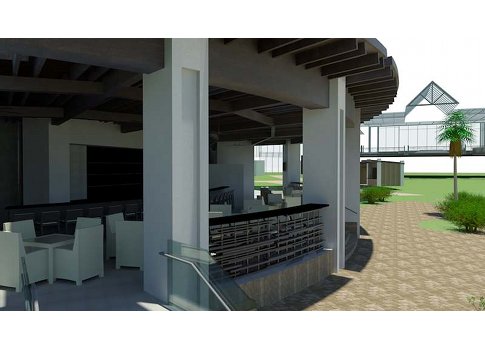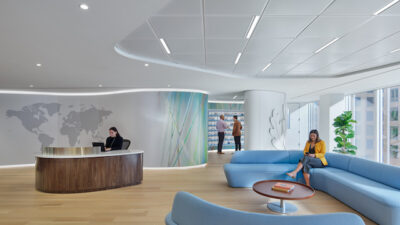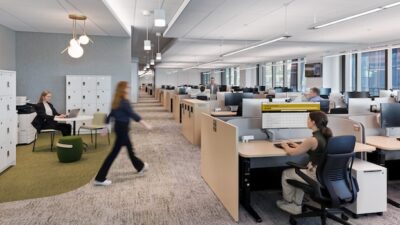Learn the steps to achieve points for the U.S. Green Building Council LEED EQc8.1: Daylight and Views – Daylight credit.

Learning objectives
- Understand the U.S. Green Building Council LEED criteria for daylighting credit.
- Learn to use modeling software to conduct a daylighting analysis.
- Learn to document and use the results of an analysis.
The use of naturally lighted spaces is a valuable strategy for achieving energy savings and earning U.S. Green Building Council (USGBC) LEED credits. Beyond energy savings, careful use of daylighting can contribute to occupant well-being and productivity. Consequently, architects and engineers are encouraged to improve their ability to apply daylighting strategies to building design solutions.
The USGBC, which administers the LEED green building rating system, has several design elements to achieve points. Daylighting is one of them. The primary standard of reference, of course, is the LEED 2009 Reference Guide for New Construction and Major Renovations.
Under LEED EQc8.1: Daylight and Views – Daylight, the intent is to provide building occupants with a connection between indoor spaces and the outdoors through the introduction of daylight into the regularly occupied areas of the building.
At the risk of making it sound too simple, daylighting design to achieve this credit point for LEED can be boiled down to three steps:
1. Understanding the criteria
2. Using the software
3. Documenting the results.
There are four options available:
Option 1: Simulation
Option 2: Prescriptive
Option 3: Measurement
Option 4: Combination of any of the above methods.
The goal for any of these options is to achieve daylighting in 75% of the regularly occupied spaces.
This article focuses on Option 1, the simulation method, defined by the USGBC as follows:
- Demonstrate through computer simulations that 75% or more of all regularly occupied spaces achieve daylight illuminance levels of a minimum of 25 fc and a maximum of 500 fc in a clear sky condition on Sept. 21 at 9 a.m. and 3 p.m.. Areas with illuminance levels below or above the range do not comply However, designs that incorporate view-preserving automated shades for glare control may demonstrate compliance for only the minimum 25 fc illuminance level.
- View-preserving shades are not part of the study in this article.
Understanding the criteria
Computer software: Physical models are an accurate way to evaluate the effects of daylighting and can be a cost-effective method of analysis. However, software programs are increasingly used to simulate and analyze daylighting effects.
Several daylighting software analysis programs can address factors such as window area, room floor area, window geometry, window height, and the visible light transmittance of glazing and factors such as orientation, room cavity ratios, visible angle to the sky, latitude designation, and interior room reflectance resulting in development of more sophisticated design strategies that demonstrate LEED compliance.
In general, the USGBC does not endorse one software brand over another. Any software that can simulate based on the requirements listed in the rating system is acceptable. The rating system does require that the simulation be done under clear sky conditions. Some of the software products for daylighting analysis are AGi32, Radiance, Lumen Designer, and Daysim.
Regularly occupied spaces: According to USGBC, "Regularly occupied spaces are areas where one or more individuals normally spend time (more than one hour per person per day on average) seated or standing as they work, study, or perform other focused activities inside a building." Some examples are private and open offices, conference rooms, break rooms, and lunch rooms.
"Non-regularly occupied spaces are spaces that occupants pass through, or spaces used in pursuit of focused activities for less than one hour per person per day (on average)." Examples are hallways and foyers.
"Non-occupied spaces are defined as spaces designed for equipment and machinery or storage with no human occupancy except for maintenance, repairs, and equipment retrieval." Examples of these include mechanical rooms, electrical rooms, storage areas, and restrooms.
Sky conditions: In 2003, the International Commission on Illumination (CIE) adopted 15 standard skies that cover a broad spectrum of the usual skies found in the world. Each sky represents a unique sky luminance distribution, which is the most effective way to classify the 15 CIE Standard Skies. Most software brands use Illuminating Engineering Society (IES) and CIE-accepted sky models to calculate the sky’s distribution in the daylight calculations. LEED requires calculations to be done on a clear sky condition (see sidebar “Things to keep in mind” linked below).
Illuminance: Output of the simulation model shall show the illumination level range of 25 to 500 fc on a clear sky condition on Sept. 21 (Equinox), 9 a.m. and 3 p.m. Footcandles shall be measured at 30 in. above the floor (desk height). (In the past, LEED required daylighting calculations to be done at noon, but now they are done at 9 a.m. and 3 p.m. when solar positions are “lower” in the sky, which help projects claim credit point because daylight should penetrate more deeply into the building.)
Using the software
Software used in this example is AGi32 by Lighting Analysts. The application of daylighting in AGi32 allows you to consider the effect of sun, sky, and ground as a light source in the environment. The daily rotation of the earth as well as its location in its orbit about the sun produces a predictable amount of sunlight at a given location. As the sunlight enters the atmosphere, a portion of the light is scattered by the atmospheric conditions. AGi32 uses many categories of sky to emulate these conditions: clear, partly cloudy, and overcast, plus 15 other general sky conditions described by the CIE. LEED 2009 requires calculations to be done under clear sky conditions.
For interior applications, the daylight will need to be “let into” the space by creating transition openings such as windows and daylight openings in the room. Exterior surfaces such as overhangs, fins, etc., that obstruct and/or reflect light into the interior environment will also be accounted for.
The building used in this analysis is a prototype office building with regularly occupied spaces having south facing (and some east facing) windows. Simulation methods generally favor south facing rooms. Using computer programs in the early stages of the integrated design process helps the designer to account for factors that influence daylighting, such as location and climate, surroundings, orientation, opening position, and size.
The Revit-based floor plan should be extracted and exported to CAD format, then imported to AGi32.
According to the AGI website, to consider the effect of daylighting in interiors, surfaces imported into or created within AGi32 must be designated appropriate surface types specifically for daylighting analysis. The following transition types are modeled with planar objects and must be located in the model to provide for daylight insolation into the interiors. These transition surfaces model the glazing portions of windows and skylights. Each planar surface represents the entire glazing assembly (glass surfaces and airspace within), using the visible transmittance (VT) value found on the glazing label. This value is the transparency specified in AGi32.
- 20: Daylight transition glass (transparent)
- 21: Daylight transition glass (diffuse)
- 22: Daylight transition opening.
Room surfaces also can be designated as a transition surface to model a window wall.
As listed above, LEED requirements for daylight spaces include a criterion that 75% of the work plane illuminance should fall between 25 and 500 fc. Our next step will place an illuminance grid and will include a parameter to show the percentage of points in this range. All of the assessment results in this study were conducted on an analysis plane positioned 30 in. above each finished floor.
We can now set the following daylight parameters for our calculations:
- Sky conditions: Clear sky
- Date and time: Sept. 21, 9 a.m. (do similar calculation for 3 p.m.)
- Location: Chicago, IL, USA
- True north = 90 (the windows face south)
- Latitude = 41 deg north; longitude = 88 deg west.
Now we are ready to run the computation.
Documenting the results
Computation results in iso-footcandle (or contour) plan shows curves or lines along which the footcandle values are constant. The plan shows these values for each regularly occupied room.
A calculation summary schedule displays the maximum and minimum values for each calculation grid, allowing you to show the spaces that comply. If you specify an illuminance grid to include the percentage points in a range, and define the range from 25 to 500 fc, you can display this information in the calculation summary schedule as well. The daylight summary schedule can also be displayed, showing the daylight parameters, site latitude, longitude, and other relevant data.
Ensure the documentation includes a narrative explaining why and what rooms are selected as regularly occupied spaces. Do not include non-regularly occupied areas. Provide drawings that show illumination simulation results and graphics. Here we need to show the output of the simulation model. Ensure parameters are spelled out: footcandles measured at 30 in. above the floor; daylighting at 9 a.m. and 3 p.m. on Sept. 21, under clear sky conditions; and following the minimum 25 fc to maximum 500 fc range.
LEED provides an opportunity to earn an additional point by exemplifying performance under the “Innovation in Design” category. Here, we need to achieve the same illuminance requirements for 95% of regularly occupied spaces under the same conditions as before.
The documentation and narrative for this prototype building are as follows:
Executive summary:
- An assessment for daylighting performance and probability of achieving LEED daylight and views credit EQc8.1 was performed for the prototype building in Chicago. The daylighting analysis was carried out using AGi32 lighting simulation software developed by Lighting Analysts in the United States and is considered one of the most recommended and accurate tools available for both daylight and artificial lighting analysis.
- The daylighting performance of the prototype building did meet the requirements to achieve EQc8.1. The overall daylighting performance is good with balanced daylight distribution. From the daylighting analysis results shown in this report, 85% of the regularly occupied space floor area is 25 to 500 fc illumination level at 3 p.m. and 75% at 9 a.m.
Creating the simulation and analysis
Simulation details include several items:
Site location:
- The building is located in Northwest Chicago, Illinois. By closest approximation, the daylight model was located at a latitude 42 deg north and longitude 88 deg west.
- All of the assessment results in this study were conducted on an analysis plane positioned 30 in. above each finished floor. The date and times for the simulation were set on Sept. 21 (fall equinox) at 9 a.m. and 3 p.m.
- The luminance sky distribution set in AGi32 lighting simulation software was clear sky.
Surface properties: The visible light reflecting properties of the internal surface finishes and transmission properties of the glazing for the individual spaces were assigned according to the surface finish and glazing schedule provided by architects (see Table 1).
Space classification: The following are selected as regularly occupied areas (as defined by USGBC) because they are spaces where one or more individuals normally spend time (more than 1 hour per person per day on average) seated or standing as they work, study, or perform other focused activities inside a building.
Daylighting analysis, including:
- Building spaces: The combined floor area of the regularly occupied spaces in the building is approximately 1462 sq ft. Most of the regularly occupied offices in the building mainly face south or east. They receive direct daylight during the evaluation time and therefore have the highest daylight levels of the offices in the building.
- Iso-contour plan and calculation summary (see Figure 1).
Achieving the goal
The daylight levels for all regularly occupied spaces were assessed individually for Sept. 21 at 9 a.m. and 3 p.m. using architectural drawings and schedules for the opaque surface finishes and glazing. The sun position and sky distribution required for analyzing the probability of achieving LEED daylight and views credit is a good criterion for evaluating the overall daylighting performance because the sun is at low angles and it is a mid-season sun.
The daylighting performance of the prototype building is balanced with even daylight distribution. All the spaces analyzed were comprised of relatively small floor areas. In this example, the daylight analysis results show the building has 85% of the regularly occupied space floor area of 25 to 500 fc at 9 a.m. and 75% at 3 p.m. Because this result meets the minimum requirement for the LEED EQc8.1: Daylight and Views – Daylighting credit, the proposed design is anticipated to achieve 1 point for this credit.
Siva Haran is a senior electrical engineer and project manager at exp. He is an advisory member of Sustainable Lighting Committee of IES. He has extensive experience in designing lighting and electrical systems for commercial, institutional, light industrial, and residential projects.
See tips for analyzing daylighting, as well as a glossary/definitions below.


